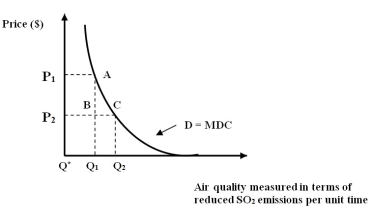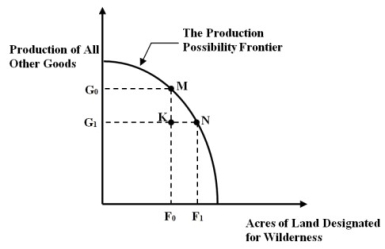Deck 8: Frameworks for Assessing the Worthiness of Environmental Projects
Question
Question
Question
Question
Question
Question
Question
Question
Question
Question
Question
Question
Question
Question
Question
Question
Question
Question
Question
Question
Question
Question
Question
Question
Question

Unlock Deck
Sign up to unlock the cards in this deck!
Unlock Deck
Unlock Deck
1/25
Play
Full screen (f)
Deck 8: Frameworks for Assessing the Worthiness of Environmental Projects
1
The advantage of a CBA is that it carries no subjectivity.
False
2
Any Pareto improvement implies that no one is made worse off.
True
3
The fundamental welfare criterion of CBA is based on "potential" Pareto
improvement.
improvement.
True
4
In evaluating the social cost of a project, double counting can become a serious
issue.
issue.

Unlock Deck
Unlock for access to all 25 flashcards in this deck.
Unlock Deck
k this deck
5
If a decrease in the price of natural gas leads to a decline in coal use for electricity
generation, one would refer to this as secondary effect.
generation, one would refer to this as secondary effect.

Unlock Deck
Unlock for access to all 25 flashcards in this deck.
Unlock Deck
k this deck
6
In general, the social discount rate is lower than the private discount rate.

Unlock Deck
Unlock for access to all 25 flashcards in this deck.
Unlock Deck
k this deck
7
The use of a very high positive discount rate indicates that the project under
consideration is very important.
consideration is very important.

Unlock Deck
Unlock for access to all 25 flashcards in this deck.
Unlock Deck
k this deck
8
Despite scientific uncertainty about the outcomes of future damages, the
precautionary principles can and should be the optimal course of action.
precautionary principles can and should be the optimal course of action.

Unlock Deck
Unlock for access to all 25 flashcards in this deck.
Unlock Deck
k this deck
9
Given that cost-effectiveness analysis (CEA) deals with least-cost method of
achieving a stated environmental goal, it is assumed that the benefits are not
important.
achieving a stated environmental goal, it is assumed that the benefits are not
important.

Unlock Deck
Unlock for access to all 25 flashcards in this deck.
Unlock Deck
k this deck
10
Rawlsian justice argues for a zero discount rate on environmental assets.

Unlock Deck
Unlock for access to all 25 flashcards in this deck.
Unlock Deck
k this deck
11
When noting the location of waste sites and other noxious facilities, one can
clearly see that they are randomly located.
clearly see that they are randomly located.

Unlock Deck
Unlock for access to all 25 flashcards in this deck.
Unlock Deck
k this deck
12
Waste facilities are often located in communities that have high percentages of
poor, elderly, young and minority residents.
poor, elderly, young and minority residents.

Unlock Deck
Unlock for access to all 25 flashcards in this deck.
Unlock Deck
k this deck
13
Economic theory and environmental justice theory are in agreement as to the
reason waste facilities are located in poor neighborhoods.
reason waste facilities are located in poor neighborhoods.

Unlock Deck
Unlock for access to all 25 flashcards in this deck.
Unlock Deck
k this deck
14
There seems to be a reverse in the trend of companies from developed nations
preferring to locate parts of their industrial operations in pollution havens.
preferring to locate parts of their industrial operations in pollution havens.

Unlock Deck
Unlock for access to all 25 flashcards in this deck.
Unlock Deck
k this deck
15
When the time horizon of a project under consideration is fairly long, the
difference between private and social discount rates that are within the range of 3 to 5 percent makes an important different.
difference between private and social discount rates that are within the range of 3 to 5 percent makes an important different.

Unlock Deck
Unlock for access to all 25 flashcards in this deck.
Unlock Deck
k this deck
16
The procedure of converting future benefits to their present values is called…
A) An externality.
B) Compounding.
C) Discounting.
D) Contingent valuation procedure.
A) An externality.
B) Compounding.
C) Discounting.
D) Contingent valuation procedure.

Unlock Deck
Unlock for access to all 25 flashcards in this deck.
Unlock Deck
k this deck
17
If a CBA has a cost-to-benefit ratio of 1.5, then…
A) The project should not be implemented.
B) The project should be implemented.
C) One should use positive time discounting.
D) None of the above are correct.
A) The project should not be implemented.
B) The project should be implemented.
C) One should use positive time discounting.
D) None of the above are correct.

Unlock Deck
Unlock for access to all 25 flashcards in this deck.
Unlock Deck
k this deck
18
A new pollution regulation allows for an interest subsidy to firms that borrow funds to
Install pollution control devices. Thus, borrowing costs are zero for the firms. In addition, the new regulation also allows for a waiver in the sales tax to firms that purchase
Pollution control devices. In his calculation, should an economist include sales tax and interest cost in the cost of the regulation?
A) Include both.
B) Exclude both.
C) Include sales tax, but exclude interest cost.
D) Include interest cost, but exclude sales tax.
Install pollution control devices. Thus, borrowing costs are zero for the firms. In addition, the new regulation also allows for a waiver in the sales tax to firms that purchase
Pollution control devices. In his calculation, should an economist include sales tax and interest cost in the cost of the regulation?
A) Include both.
B) Exclude both.
C) Include sales tax, but exclude interest cost.
D) Include interest cost, but exclude sales tax.

Unlock Deck
Unlock for access to all 25 flashcards in this deck.
Unlock Deck
k this deck
19
Which best describes the decision criterion for implementing either a private or public
Project?
A) Costs should not exceed benefits.
B) A cost-to-benefit ratio should be less than unity.
C) Benefits should exceed costs.
D) All of the above.
E) None of the above.
Project?
A) Costs should not exceed benefits.
B) A cost-to-benefit ratio should be less than unity.
C) Benefits should exceed costs.
D) All of the above.
E) None of the above.

Unlock Deck
Unlock for access to all 25 flashcards in this deck.
Unlock Deck
k this deck
20
Which of the following does not represent a potential issue when using the contingent valuation method?
A) Precise explanation of environmental attribute being valued.
B) Possibility of respondents ignoring income constraint and ignoring availability of
substitutes of goods being valued.
C) Possibility of respondents misstating their willingness to pay.
D) Inappropriate for estimating non-use value of resources.
A) Precise explanation of environmental attribute being valued.
B) Possibility of respondents ignoring income constraint and ignoring availability of
substitutes of goods being valued.
C) Possibility of respondents misstating their willingness to pay.
D) Inappropriate for estimating non-use value of resources.

Unlock Deck
Unlock for access to all 25 flashcards in this deck.
Unlock Deck
k this deck
21
The rate at which future money is discounted in a cost-benefit analysis is referred to as
The…
A) Real rate
B) Nominal inflation rate
C) Discount rate
D) Time preference rate
E) Social rate
The…
A) Real rate
B) Nominal inflation rate
C) Discount rate
D) Time preference rate
E) Social rate

Unlock Deck
Unlock for access to all 25 flashcards in this deck.
Unlock Deck
k this deck
22
As part of a CBA, risk should…
A) Always be considered.
B) Never considered.
C) Be calculated only as part of social, but not private projects.
D) Only be used in private projects because it is difficult to calculate.
E) None of the above.
A) Always be considered.
B) Never considered.
C) Be calculated only as part of social, but not private projects.
D) Only be used in private projects because it is difficult to calculate.
E) None of the above.

Unlock Deck
Unlock for access to all 25 flashcards in this deck.
Unlock Deck
k this deck
23
Figure 8A

-Refer to Figure 8A. In a CBA, the objective is to move from state B to state C implies which of the following?
A) Status quo to status quo.
B) A move that results in no difference in environmental quality because the price
has not changed.
C) A change in position to "better" that is attained after implementation of sulfur
emission control technology.
D) A change in position to "worse" that is attained after implementation of sulfur
emission control technology.
E) None of the above.

-Refer to Figure 8A. In a CBA, the objective is to move from state B to state C implies which of the following?
A) Status quo to status quo.
B) A move that results in no difference in environmental quality because the price
has not changed.
C) A change in position to "better" that is attained after implementation of sulfur
emission control technology.
D) A change in position to "worse" that is attained after implementation of sulfur
emission control technology.
E) None of the above.

Unlock Deck
Unlock for access to all 25 flashcards in this deck.
Unlock Deck
k this deck
24
Figure 8A

-Refer to Figure 8A. In a CBA, the objective is to move from state A to state C implies
Which of the following?
A) Status quo to status quo.
B) A move that results in no difference in environmental quality because the price
Has decreased.
C) A change in position to "better" that is attained after implementation of sulfur
Emission control technology.
D) A change in position to "worse" that is attained after implementation of sulfur
Emission control technology.
E) None of the above.

-Refer to Figure 8A. In a CBA, the objective is to move from state A to state C implies
Which of the following?
A) Status quo to status quo.
B) A move that results in no difference in environmental quality because the price
Has decreased.
C) A change in position to "better" that is attained after implementation of sulfur
Emission control technology.
D) A change in position to "worse" that is attained after implementation of sulfur
Emission control technology.
E) None of the above.

Unlock Deck
Unlock for access to all 25 flashcards in this deck.
Unlock Deck
k this deck
25
Figure 8B

-Refer to Figure 8B. Suppose point N on the production possibility frontier represents the status quo. Recently, a relaxation of environmental standards allows a country to move to point K. Which of the following best described the results from this move?
A) No one is made worse off.
B) Everyone is made worse off.
C) Pareto improvement occurs.
D) This situation can never occur in reality.
E) None of the above.

-Refer to Figure 8B. Suppose point N on the production possibility frontier represents the status quo. Recently, a relaxation of environmental standards allows a country to move to point K. Which of the following best described the results from this move?
A) No one is made worse off.
B) Everyone is made worse off.
C) Pareto improvement occurs.
D) This situation can never occur in reality.
E) None of the above.

Unlock Deck
Unlock for access to all 25 flashcards in this deck.
Unlock Deck
k this deck



